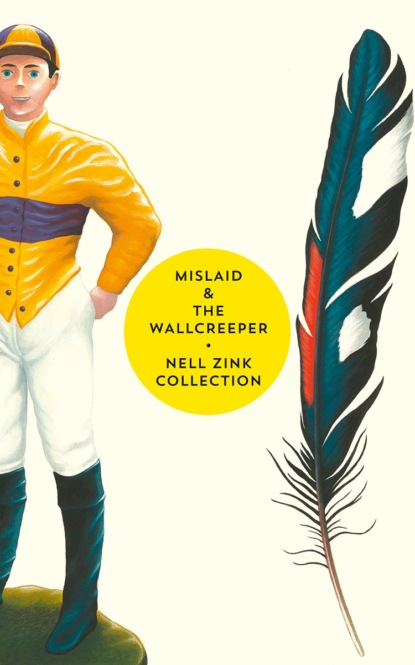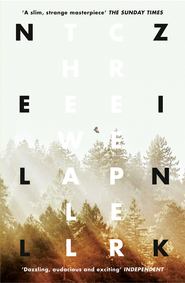По всем вопросам обращайтесь на: info@litportal.ru
(©) 2003-2024.
✖
Mislaid & The Wallcreeper: The Nell Zink Collection
Автор
Год написания книги
2019
Настройки чтения
Размер шрифта
Высота строк
Поля
“Rabbit is not rich, and fur is tacky anywhere south of Vermont. Rabbit is poor tacky. Rich tacky would be fox. A girl your age could wear dyed sheared beaver, maybe, if she lived on the shores of Lake Baikal.”
Karen frowned.
Meg felt more strongly than usual that many thoughts life had taught her to articulate were not her own, while many of her thoughts went unexpressed for lack of a suitable audience.
For this and other reasons, she concluded that although she desperately needed someone to talk to, she also needed a career where you work alone and don’t get roped into chatting with people on any subject whatsoever.
She looked glumly at the typewriter and poured herself a drink.
Her writing was going well enough. She told herself she was honing her craft and would soon be making money. But it was like honing a primitive stone tool, not a forged blade. Life with Lee had taught her to be laconic. She could quip. So her plays all ended on page two.
Typically they were murder mysteries with no mystery. A woman sneaks across the stage and plunges a knife into the neck of a sleeping man. He says a few choice last words and dies. She expresses her ambivalence as the police come to haul her away.
Meg’s first paycheck materialized as she drove to the grocery store early one morning. She saw a cardboard box on the shoulder. She stopped, because a box like that nearly always contains kittens. Not worth money, but tell that to Karen. Karen worshipped kittens as gods.
Except this box was full of pornographic magazines from England. Dry, clean, and in excellent condition. What mysterious denizen of the county had felt called upon to make an obviously cherished collection vanish anonymously? Frightened of being observed at the wayside Dumpsters, hitting the brakes for a second or two to unload years of costly, intimate personal history … or had his wife done it? The girls were chunky, posing in what appeared to be their own backyards, private parts concealed by fluffy fur and sometimes adorned with ribbons. They were lavish, glossy mags on heavy paper. No amateurs, no swingers, no contact information, just girls next door, apparently the first to return after the neutron bomb was dropped on Folkestone, because how else could they romp naked in middle-class gardens with low hedges and sea views?
Meg felt on some level it was the strangest thing she had ever seen: innocent porn. No wonder it had to go. A wife who discovered it could no longer feel superior to the whores in her husband’s freak books. She would see that in England, for reasons unknown, a woman can simultaneously be cute as a bug’s ear, a serious rose gardener, and a nymphomaniac. The false dichotomies promulgated by Tammy Wynette et al. would vanish like morning fog, leaving her alone with her self-doubt.
Or were they the possessions of an old man, trying to manipulate how he would be remembered? His heirs, trying the same thing? Was he rich, poor, addicted to Masterpiece Theatre, raised in the Church of England, in love with flowers, an Englishman?
There was no way of knowing. The cover price was high, suggesting a wealthy man, but pornography is a classic payday splurge for the shiftless.
The magazines didn’t turn her on. One woman standing over another with a whip, absentmindedly fingering its thick, braided handle: that image, seen for a fraction of a second while leafing through a coffee-table book in the Lambda Rising Bookstore in Georgetown before she fled blushing, was burned into her memory, and she seldom had an orgasm in which it was not implicated. These girls, with their apple cheeks and dahlias, were by contrast disquietingly perverse. But they had to be worth money to someone.
She weighed her options. The county did in fact have a junk shop. It lay in the crook of an unfinished half-moon road, just off the new four-lane highway. She got twenty dollars for thirty-eight magazines, but the shop owner leered in such a way that it was clear to her she would never again sell pornography to a filthy-minded good old boy. Since that demographic sort of dominates most aspects of the pornography market, her days in the secondhand sex industry were over almost before they began.
But the scavenging bug had bitten her. Her next find was a dead raccoon. She took it straight to the bait shop and sold it to the bearded white guy behind the counter for six dollars. He said in good repair they could go as high as ten.
Roadkill in good repair: not an easy assignment, even at first light. She started swinging by the county dump several times a week.
Like Dante’s Inferno, the dump had circles. The outer circle was where people unloaded discrete and possibly salvageable objects such as planks and furniture. In the next circle, plastic sacks hit the ground and were pushed into piles with a front loader, and somewhere back of that were the looming brown mountains of decay and the overweight turkey buzzards that couldn’t fly.
It was to these mountains that items were taken directly when no one was supposed to know they were in the dump, for instance human bits and parts from funeral homes. It was also said that a certain white man who had treated people badly had driven his pickup deep into the dump to unload construction trash, and while he was still in his cab a black man at the controls of a lordly Caterpillar had unceremoniously covered him with dirt and shoved his truck, still running, into the mountains of the dump, burying him alive. Whether he was crushed or asphyxiated or fell unconscious from the fumes or rotted from the inside out due to the radioactivity of his load depended on whom you asked. The truck had never been found, nor looked for, because people were scared of the radiation.
Or so the story went. There was no question of his having vanished in the usual way. He would never run out on his family like that.
Meg first heard the story on her return visit to the junk shop with a chair from the first circle of the dump. The shop owner said he leaned toward the carbon monoxide theory as being more “mercified.” Meg said she didn’t believe anything about it, because the police would surely investigate the death of a white man and arrest eight or ten black people just to get started.
“Not if the sheriff wants reelection they don’t,” the shop owner said. “This is the New South. Niggers have impunity.” Nodding sagely, he drained the day’s eleventh can of Georgia Iced Tea (Busch).
Trash picking did not bring Meg much money. But enough for peanut butter and store-brand Cheerios with a brittle crunch like powdered glass, plus Karen’s favorite nondessert food in the world, BLT. Mayonnaise is an irresponsible splurge when you don’t have a fridge, but there are small sizes available, especially in places where people live hand to mouth and “large economy size” is regarded as a long-term investment that would tie up needed capital. The bait shop sold mayonnaise in jars barely bigger than a film canister. Polishing off a package of bacon at one sitting was no problem for Karen.
“If you are what you eat, I’m bacon,” she announced blissfully one day. Meg imagined her mother hearing this, and felt grateful they were not in touch.
Someone driving by saw a man get out of a van in front of Meg’s house and mentioned it at Mrs. Sutton’s Restaurant. Soon it was common knowledge that she had a white boyfriend.
White in Virginia in those days was a fairly narrow category. It didn’t include anyone with dark hair, such as … such as … such as people with dark hair, who on good days were called “Spanish.” But it made room for the red cheeks, green eyes, and thinning rat-tail braid of Lomax Hunter, a Mattaponi Indian.
They met not long after Meg started collecting night crawlers. Leaving Karen asleep on the backseat of the car, she would wander around with a miner’s headlamp, staring at the ground. There weren’t many places with good lawns, just a few churches and cemeteries, but when it worked it was a license to print money. A dozen night crawlers was worth fifty cents at the bait shop, and on a dark night after a rain you could pick up a dozen in three minutes, which makes ten dollars an hour. You have to be sneaky, because other people will horn in on your night crawler grounds. Meg was not up for turf battles, especially not nocturnal single combat with strange men. When she scented competition, she drove away. Gradually Karen was getting too old to pass out automatically if you laid her down, and too big to hide under a towel. Big enough to be conspicuous, so you wouldn’t want to leave her alone unconscious in the places frequented by the drifters who gather night crawlers. So that ultimately night crawlers were a glorious, lucrative interlude, nothing more—the first of many fitful, sporadic, hand-to-mouth seasons of wealth, adequate to cement in Karen’s mind an indestructible association between worms and Pepperidge Farm cakes.
Put off by the competition for worms, Meg thought it over and decided to hunt for ginseng instead. Ginseng grows in the woods in daylight, where a child can help you look for it. Even sassafras will bring in money, they say. There’s all kinds of valuable stuff growing in the woods.
The bearded man who ran the bait shop said he would miss her gentle touch with the worms, as many of his suppliers grasped the worms too tightly and injured them. He put Meg in touch with a hippie who dealt in herbal medicines.
As it turned out, this hippie was not in the ginseng and sassafras business. But he said he could give her fifty cents per psilocybin mushroom.
“We got more cow patties than lawns,” Meg said. “Fifty cents a shroom beats four cents a worm any day of the week.”
“You got that right,” Lomax replied. “Drugs is where the money’s at.”
Lomax was a middle-class Indian. Rather than on the Mattaponi reservation, he grew up in a tract house in Spotsylvania County. Both his college-educated parents had office jobs pushing paper in the highway department. A social outcast at work, Lomax’s father had become an avid chipmunk watcher. The house’s large, flat backyard was the scene of unceasing warfare among the solitary ground squirrels, except in mating season, when they pursued momentary alliances that provided for nonstop action and inaction. He had founded a chipmunk conservation group and authored its bylaws.
Stoned, even at age ten, Lomax found the chipmunks easier to take. His mother sympathized. Of her three children, Lomax was her favorite. He never caused her any trouble. No sports, no extracurricular activities, always willing to talk to her husband about his hobby.
Lomax’s home life taught him to value harmony, but school told him that Indians were wild, nonconformist rebels. The Chanco story in fourth-grade Virginia history laid the groundwork, and Billy Jack and Wounded Knee put the icing on the cake. He dropped out and bought a Dodge van with his drug-dealing proceeds, informing his parents he was heading west to join the Ghost Dance. He got as far as Bristol, Tennessee. At seventeen he declared his financial emancipation and moved into the van in the yard with the chipmunks. He applied for SSDI (Social Security Disability Income) with a letter from a psychologist at a National Guard recruiting center.
At twenty-one, certified unemployable, Lomax could pass for a middle-aged man. He was starting to lose hair up top, and his pot belly put a strain on his shirts. His meetings with Meg always started with the same ritual greeting: “Yo, Chief!” To which he replied, “What up, Poodlehead?” She would send Karen outside to play and spread her haul of psychedelics on the table. He would sort the mushrooms into fat and soft (fifty cents apiece) and scraggly and moldy (fifty cents a dozen, a folk aphrodisiac for livestock). She would pour him a glass of Seagram’s gin and they would talk.
Lomax was a talented raconteur. At their first business meeting he described visiting the Mattaponi reservation with the Order of the Arrow and what a drag that was—the chief dressed up like a Sioux in a hawk-feather wig and moose-hide bedroom slippers—until he talked a boy into eating jimson berries. The kid went out-of-body and couldn’t find the piss button. They ended up at the hospital getting him catheterized. The twists and turns in Lomax’s story made Meg laugh. By their sixth meeting he regarded her as an intimate friend. He made her listen to his heart, which was beating about a hundred times a minute.
“And I’m just sitting here!” he said proudly.
“And you get SSDI for being insane? Man, if my heart was fucked up, that’s what I would get disability for.”
“No, man, that’s stupid. Because if your body’s fucked up you can still work, like keypunch or a switchboard operator. But if your mind is wasted, you’re certified unemployable. They won’t even draft your ass.”
Meg said that she had never applied for public assistance in any form, not even the free school lunch, and Lomax nodded.
“I can appreciate that. In my line of work, you like people minding their own business. One girl, she pulled a disappearing act last year, I had to hand it to her. I went down to see her and her place was trashed. Floorboards pried up. Electric sockets hanging out the wall. But I know she’s all right, because she had two Chesapeake Bay retrievers. The one of them had a head on it like a bear. It could bite through your tires. The other one was the most nervous animal I ever saw. They was both laying dead in the mudroom. She could only have shot them herself.”
“Wait a second.” Meg looked at him questioningly. “She shoot her own dogs?”
“Nobody else could get close enough to those dogs to shoot them,” he assured her. “She couldn’t take them down to Dominica. There’s a quarantine.”
“She’s in Dominica?”
“I don’t know! She might be in Cuba or Antigua.” He shrugged. “No human soul ever put the time she did into dog food. Every day she made them a pot of stew. If she had to go, it was a mercy she killed them. Sometimes you have to think about the best interests of the animal.”
After Lomax drove away, Meg considered his remarks on the dogs and decided an alarm system might be in order, as well as a way of storing cash and drugs that didn’t involve the bed where she slept.
She took Karen down to the shelter and let her pick. And thus it was that they acquired a six-year-old spayed cockapoo bitch named Cha Cha and eventually several sets of nesting Tupperware suitable for burial in the yard.
It was their eighth meeting before Meg knew there was a girl sitting outside in Lomax’s van the entire time, and only because Karen brought it up. Karen asked whether the girl in the van could come out to play, and he promptly responded, “She’s a little old for that. She’s my girlfriend.”
Karen objected. “I’m not old, and I have a boyfriend!”
“What’s his name?”








